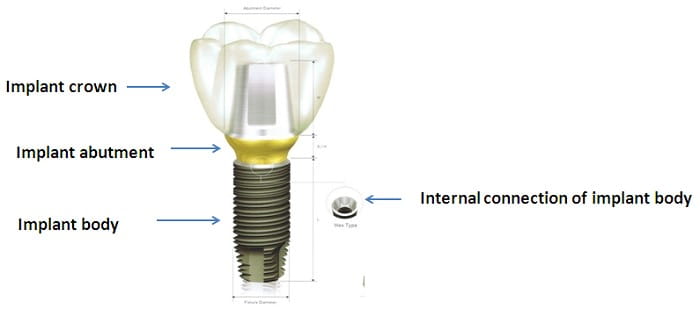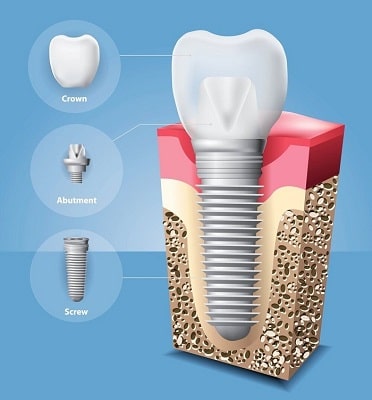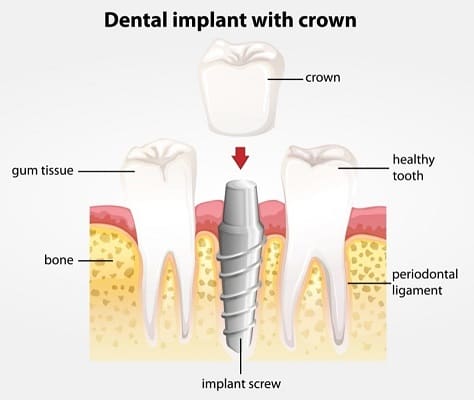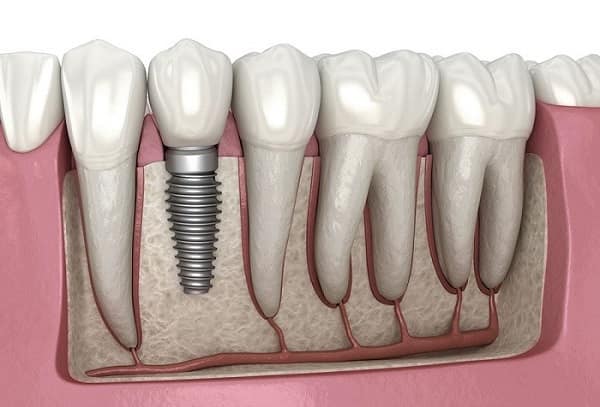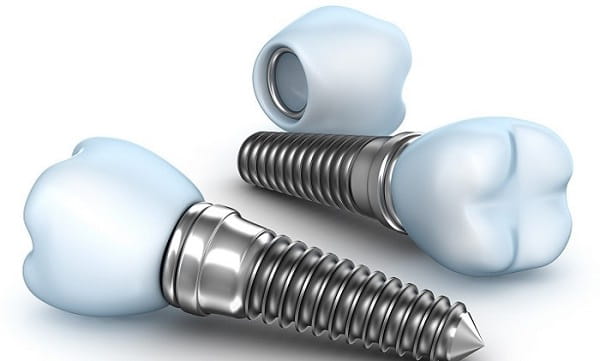Implants are quite rightly regarded as the royalty of tooth replacement. The artificial tooth mechanism seems more worthy of wearing the crown than the cap procedure is of having it as an a.k.a name, and it’s more effective and less intrusive than both the partial denture and dental bridge alternatives which suspend artificial teeth into gaps with the support of healthy teeth.
Most implants work on similar principles and have three similar components, the body, the abutment and the crown. At the jawbone level, the body which will ultimately support the entire structure is implanted in or on the bone, and the abutment or post-like support for the visible porcelain crown is attached to it. And in most instances, a false crown is attached first to give the gums a chance to heal before the final ceramic crown is attached.
Dental implant parts
Dental implants with three main components have been widely used for decades and are tried and tested, providing a reliable treatment outcome.
The Implant Post
The implant post or screw is inserted into the jawbone during a short surgical procedure using advanced computer guided surgery. The actual post looks a little like a natural tooth root, which is precisely the way it’s designed, so if you see an implant post, you may notice its end is tapered just like a real tooth root.
Dental implant posts are available in a huge variety of different diameters, ensuring dentists can choose the most appropriate diameter for the tooth requiring restoration.
For example, a larger diameter is more suitable for larger teeth, such as a molar, while a narrow diameter implant is more suited for smaller teeth such as incisors. The length of dental implant posts also varies according to the size and location of the tooth to be replaced.
An implant post may be up to 18 mm in length, and for example, mini dental implants tend to have longer posts for greater strength and stability. A conventional dental implant post is hollow so that the abutment can be screwed onto the post.
A three-piece implant design allows the implant posts to be covered up for osseointegration, so it isn’t necessarily restored immediately with the prosthesis. Instead, the abutment is attached later when the implant dentist is ready to fabricate and fit the implant prosthesis.
Implant Abutments
There is a huge range of implant abutments dependent on the implant system used to restore teeth. For example, implant abutments that secure implant crowns and bridges are very different compared to abutments used to support dentures. An implant abutment used to secure a crown or bridge looks a little like a tiny tooth stuck, protruding above the gum line.
Abutments used to support a denture are very different, as the denture implants can have special attachments on its fitting surface and which clip onto the abutments, or the abutments are used to support a bar. The denture then clips directly onto the bar.
Restoration
After the abutment is properly healed and securely in place, a restoration can be attached to the abutment. Your restoration could be a crown, bridge or denture depending on the number of teeth being replaced.
Crown
A dental crown will be attached to the abutment if a single tooth is being replaced. Dental crowns are typically ceramic, or a mixture of metal and porcelain. To create a natural looking tooth replacement, the crown will be is screwed or cemented onto the abutment.
Bridge
If you are replacing a number of teeth in a row, a dental bridge may be used. Bridges are usually made from porcelain and are attached to just two implants which hold it securely in place. The artificial teeth in a dental bridge will be colour matched in order to blend in with the natural teeth.
Denture
For patients who are replacing a full jaw of teeth, an implant supported denture can be used.
Conventional dentures rest on the gums and are held in place by suction. Implant supported dentures are held securely in place with the help of dental implants.
Implant supported dentures can give patients a natural looking smile. These dental restorations are typically made with either plastic or porcelain teeth attached to an acrylic base which is coloured to look like the natural gum line.
What to Expect During Your Dental Implant Procedure?
A dental procedure involving surgery does not create any feelings of comfort. But, perception may be greater than reality in this case. If a person is wondering what a dental implant procedure is like, here is what they should expect during the procedure.
Impressions of the teeth
During the impression-taking process, the patient bites down on a gel that hardens to create the impressions of the inside of their mouth on the gel. The dentist fills a u-shaped tray with the gel and places it in their mouth.
Most patients do not feel any uneasiness during this step of the treatment. But, some patients need to be kept from panicking (because their mouth is not opening properly) or gagging (because they have an active gag reflex).
Dentists use several techniques to distract the patient so that they feel comfortable. Some dentists engage with the patient by talking with them and assuring them that they are nearly done with the treatment. Patients can use their own “methods of distraction” as well: they can watch the TV or use their imagination. If they still feel anxious, they can ask the dentist to use laughing gas.
Extraction of the remaining tooth
Some patients need an extraction to remove the tooth where the implant will be placed. The patient is given anesthesia for the extraction so that it is a painless procedure. After the extraction, the patient is not allowed to do certain things, such as smoke or consume chewy foods for the next 24 hours.
Placement of the dental implant
The main surgery is also done under anesthesia. As the hole is drilled in the jaw bone, the patient will feel a vibration because of the drilling. After the procedure, patients usually feel discomfort but not pain. The discomfort can be minimized by using over-the-counter medication. The doctor will also prescribe antibiotics to avoid any infections from forming.
The whole procedure may last one or two hours; however, it is a good idea to not have any commitments for the rest of the day because the duration of the procedure will be different for every patient. Patients usually do not need assistance after the implants are placed and are allowed to drive home if they wish.
Advantages and Disadvantages
The claims are not just idle boasts according to the long list of advantages assigned to using implants. Among these are implants’ comfort and convenience; their natural appearance; and their low impact on speech and the ability to eat. To cap it all, they are seen as lasting the longest of the tooth replacement options and putting the least strain on surrounding teeth.
However, it’s not all sunshine and roses. Some disadvantages do dim the royal glow. These include the need for surgery, which by its nature brings with it a healing period and carries the threat of infection. Implants also require adequate bone to support them, and there is a chance that during their lifespan (which is cited at anything up to 20 years), problems might rear their heads in terms of the implants’ components with regard to possible mechanical failure and the dental crown fracturing at some point.
Implants also involve a commitment to high levels of oral hygiene and regular dental visits to ensure their longevity, but then again that’s a commitment that applies to other tooth replacements and our natural teeth, if we want them to last a long time.
Cost of dental implants
Several factors will influence cost, including the need for tooth extraction, the condition of the bone and gums and the need for a graft. Besides these factors, the price may also vary based on location.
Normally the fear of the treatment is greater than anything that happens during the procedure. It is the responsibility of the dentist to properly explain each step to their patients. To avoid any surprises, be sure to note all of the steps explained by the dentist and ask if any written materials are available to take home with you. Talking with someone who has undergone a similar procedure can be helpful as a well.

